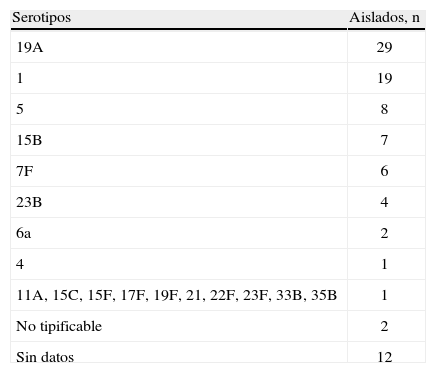Nuestro objetivo es analizar la evolución de serotipos de Streptococcus pneumoniae invasores en pacientes pediátricos y su patrón de resistencia antibiótica, con especial atención a los primeros resultados obtenidos tras la incorporación, en junio de 2010, de una vacuna conjugada 13-valente (VNC13) en la Comunidad Autónoma de Madrid (CAM).
MétodosDurante 2007–2011 se identificaron 100 casos (96 pacientes) de enfermedad invasora neumocócica (EIN). La sensibilidad a penicilina y cefotaxima se determinó por microdilución. El Laboratorio Regional de Salud Pública (CAM) realizó la serotipificación.
ResultadosEn el Hospital Infantil Niño Jesús de Madrid, hubo 100 aislados de neumococos, 88 en sangre y 12 en líquido cefalorraquídeo. El 50% de los pacientes eran menores de 2 años. Se identificaron 18 serotipos: el 29% con serotipo 19A, causa del 55% de las EIN en menores de 2 años. El 10% de las cepas eran resistentes a penicilina (NRP) y el 4%, a cefotaxima. Siete de las 10 cepas de NRP pertenecían al serotipo 19A. Los serotipos 1, 5, 7F, 6A y 19A disminuyeron en el periodo post-VNC13 (2010–2011). Entre 2007 y 2009 hubo un aumento progresivo de EIN por serotipo 19A con predominio de cepas sensibles a penicilina. Entre 2010 y 2011 disminuyeron paulatinamente y en 2011 las EIN se deben por igual a aislados de 19A sensibles y resistentes.
ConclusionesLa VNC13 reduce la EIN por serotipos contenidos en ella, especialmente el 19A. Ello conlleva una disminución de resistencia a penicilina. En nuestra serie, parece que el impacto de la VNC13 se produce en una población colonizadora, mayoritariamente sensible, probablemente por el tiempo insuficiente desde la incorporación de VNC7 en la CAM..
The objective was to analyse the trends of invasive pneumococcal serotypes and antimicrobial resistance patterns in children in the Madrid Autonomous Region (CAM), paying special attention to the first results obtained after the introduction in June 2010 of a 13-valent pneumococcal conjugate vaccine (PCV13).
MethodsDuring 2007–2011, 100 cases (96 patients) of invasive pneumococcal disease (IPD) were identified. Susceptibilities to penicillin and cefotaxime were determined by microdilution. The strains were sent to the Madrid Regional Public Health Laboratory for serotyping.
ResultsA total of 100 isolates of pneumococcus were made at the Hospital Infantil Niño Jesús, Madrid, 88 in blood and 12 in cerebrospinal fluid. Fifty percent of patients were aged <2 years. Eighteen serotypes were found. Serotype 19A was found in 29% of cases: 55% of IPD in children aged <2 years was due to 19A. Ten percent of isolates were penicillin non-susceptible (PNS) and 4% cefotaxime non-susceptible. Seven out of ten PNS strains were 19A. Serotypes 1, 5, 7F, 6A and 19A decreased after introduction of PVC13. Between 2007 and 2009, there was a progressive increase in IPD due to serotype 19A, with a predominance of penicillin-susceptible strains. This increase decreased slowly in 2010 and 2011 and in 2011 IPD was due in equal parts to susceptible and PNS 19A strains.
ConclusionsPCV13 reduced the incidence of IPD due to vaccine serotypes, especially 19A. The reduction was linked to a reduction in penicillin non-susceptibility. Our findings suggest that the impact of PCV13 on pneumococcal colonization could be exercised on a predominantly susceptible population, probably due to the insufficient time after implementation of PCV7 in Madrid.
Artículo
Comprando el artículo el PDF del mismo podrá ser descargado
Precio 19,34 €
Comprar ahora










